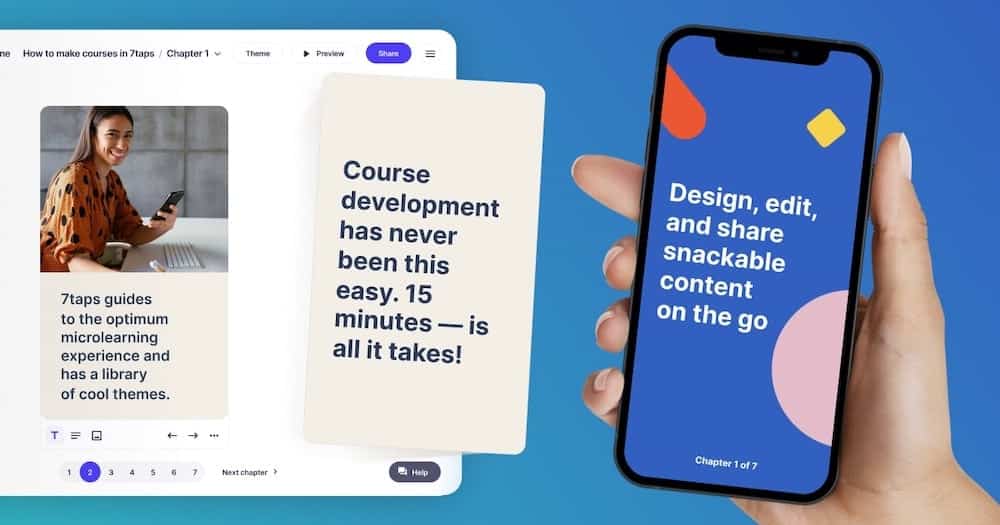As an organization, ELM Learning is always looking for new tools, ideas, and philosophies to make your training more impactful. Whether it’s going to conferences, attending virtual meetups, or scouring the internet for the latest trends and opinions, when we see something exciting, you’ll be the first to know. When we came across 7taps for eLearning, our instructional-design wheels started turning and we knew it might be the next macro idea for microlearning.
Microlearning is nothing new in the eLearning space. We know that complex topics go down a lot smoother when they’re broken into digestible pieces. But 7taps takes the idea of microlearning to the next level, making it more accessible to large organizations and small businesses alike. By streamlining the process and coming up with slick, bite-sized templates, 7taps could be the answer to your training woes.
What is 7taps?
Think of the last time you got caught up scrolling through TikTok and Instagram Reels. One of the reasons social media is so addictive is that the algorithm naturally brings you to another video, then another, then another; suddenly, it’s been an hour and you totally forgot you were supposed to make dinner. 7taps works in a similar way, making it easy for users to tap through their training, absorb small bites of information, and move on.
When you create a course with 7taps, the free, web-based tool helps you organize your content into “story cards” that keep a training session to less than 10 minutes a pop. Templates are predesigned and have the ability to bring quizzes, GIFs, podcasts, videos, graphics, and text into each card.
The tool leads you through the process, and you simply drop in your content as you build your micro lesson. The finished product is reminiscent of an Instagram Story: a quick succession of short pieces of content that contribute to the bigger picture.
When is 7taps useful?
Like all eLearning authoring tools, 7taps has scenarios where it’s particularly useful. While it’s not the perfect solution for all training, there are definitely times when it makes sense for both small and large organizations. We suggest using 7taps when:
- You’re on a tight schedule. One of the biggest benefits of 7taps is how quick and easy it is to use. There’s hardly a learning curve at all; the tool is incredibly intuitive and the directions are simple. If you’re in a situation where you needed to deploy training yesterday, 7taps can have you up and running in about 30 minutes.
- You’re on a tight budget. The basic version of 7taps is currently free, and versions with more complex features and multiple users starting at about $100/month. When compared to other authoring tools or using an eLearning vendor to create a course from scratch, it’s a cost-effective way to build a simple, eye-catching module.
- You need a refresher course. While it might not be the best tool for introducing complex topics, we love microlearning as a refresher. Sometimes, all learners need is a quick interaction to jog their memories or practice their skills. 7taps makes it easy to give your learners a bite of training to improve recall from past learning experiences.
- You’re struggling with completion. We get it: learning completion rates can be hard to nail down and sometimes disheartening. When you try to create impactful training only for learners to bail halfway through, it’s a double-whammy of your training not reaching its full potential and your learners not getting the information they need. 7taps boasts a 99 percent completion rate, owing to the quick and addictive nature of their story cards. The 7taps portal also allows you to manage open rates, progress, and completion rates so you have better analytics and can make more informed training decisions.
- You need to reach a wide audience. Because 7taps doesn’t require any extra tech and is simply viewed via web browser, it’s ideal for wide audiences. In today’s virtual workspace environment, it’s tricky to strike the right balance between accessibility and community. Even the free version of 7taps allows unlimited users and integration for engaging graphics, surveys, and feedback to keep everyone on the same page.
- You’re using a blended approach. Microlearning always works best in tandem with other methods of eLearning. Think of it as the fast food of learning experiences: it can really hit the spot when you need something quick and cheap, but it wouldn’t be the best choice all the time. A tool like 7taps is best when it’s part of a holistic learning strategy that also includes more in-depth training, instructor-led sessions, and practice scenarios.
The benefits of microlearning
The reason 7taps is so interesting to us at ELM Learning is because it is part of the industry’s evolution toward the utilization of microlearning—and we really, really love microlearning. Microlearning taps into the brain’s natural way of receiving, absorbing, and storing information. It’s true that attention spans get shorter every year, and microlearning uses that to the greatest benefit by hacking what attention span is available.
There are four key elements at play behind the psychology of microlearning:
- Repetition. When you keep learning concepts small, you can repeat them more often without causing learner fatigue. These tiny nuggets of information, shown again and again, help deepen the neuro-connections between user and content for long-term recall.
- Recall. Microlearning helps reduce the pressure on the brain to remember large portions of information and instead focus on just the key important parts for later recall and actual behavioral change.
- Assessment. Microlearning—especially when used with tools like quizzes—encourages learners to prove their mastery before moving on to another topic. They can self-assess to decide if they can keep going or go back to try a quick refresher again.
- Interleaving. It’s rare that microlearning focuses on just one concept at a time. Consider using microlearning for onboarding, for instance: it might have mini-modules on everything from employee conduct to policies and procedures. Microlearning makes it easier to interleave these topics, a process by which mixing several topics together actually improves learning. Alternating bite-sized micro-topics gives you more flexibility to “chunk” concepts together in a more logical way.
Conclusion
Here’s the thing: even if you know that microlearning is a better way to train, you might not automatically realize how to best “chunk” your content and how long each lesson should last. 7taps takes a lot of the guesswork out of the process, leaving you with a beautifully dynamic module that can be shared and tracked from the 7taps portal.
It might seem counterintuitive for an eLearning company to be so excited about a tool that makes in-house course creation easier and faster, but we believe that in this industry, when one of us wins, we all win. One small step for microlearning is a giant step toward helping your learners reach their full potential: no matter how they get there.
Can we help you design more dynamic, interactive eLearning? Contact us and let’s get started.






